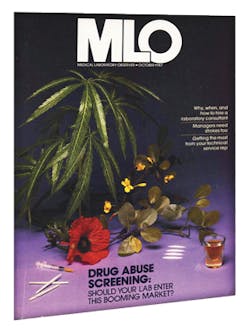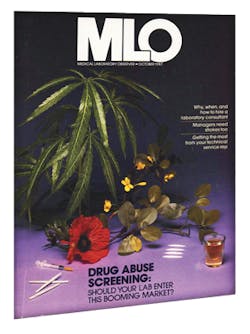Novel psychoactive substances (NPS)
One of the current and most challenging areas for drug-testing in both clinical and forensic laboratories is that of novel psychoactive substances (NPS). The chemical make-up of these substances is constantly evolving, which means that laboratories are facing a serious problem when it comes to detection.
Synthetic cannabinoids, more commonly known as “spice,” are one of the most prevalent NPS and have been marketed as legal versions of cannabis since around 2008—so they are not a new problem. NPS compounds are designed to circumvent government legislation as suppliers continually tweak their products. As active ingredients are synthesized in unregulated laboratories, the drug quality also varies considerably.
There has been a rise in the international prevalence of NPS. In the United Kingdom, call-outs to paramedics for treatment of adverse effects from NPS have increased significantly in recent years. Scotland now has an average of six emergency NPS call-outs per day. Adverse effects may include confusion, agitation, and drowsiness, and a small number of deaths have been linked to these compounds. There have also been reports of patients demonstrating extreme aggression and paranoia.
Due to the novel nature of these compounds, the metabolic pathway is often not known, and that makes it more difficult to devise tests for their detection. As some drug users are moving away from the typical drugs of abuse that fall into the standard testing profiles, it is important for the clinical testing laboratory to keep up with the evolving nature of NPS.
Samantha Stewart
Toxicology Scientist
Randox Testing Services
The future of toxicology testing in the clinical lab
2016 will usher in changes in the way laboratories are reimbursed for their toxicology testing. For mid-size to large laboratories, the changes will not greatly impact total revenue.
CMS (Centers for Medicare & Medicaid Services, previously known as the Health Care Financing Administration) published the Clinical Laboratory Fee Schedule (CLFS), which mandated a lower reimbursement for presumptive testing starting January 1, 2016. Familiar codes, such as Codes G0431 and G0434, were eliminated, and three new codes are in place for presumptive testing. For the presumptive instrumented testing the complexity no longer impacts reimbursement. Cups, strips, and other visually read tests are impacted by reimbursement reductions more than instrumented testing. Smaller laboratories may decide that it is no longer cost-effective to utilize the cups or strip method of testing and instead send out to a reference laboratory.
CMS has added four additional codes that will be implemented for the definitive testing in 2016. The reimbursement for this definitive testing has also been decreased, which could make it more difficult for small and medium-sized laboratories to cost-effectively implement new definitive methodologies. Laboratory leaders might choose to consult with a coding specialist, to better understand how these changes may impact their individual lab.
Overall, laboratories that perform toxicology testing will become more focused on what is needed as a STAT test and what testing should be sent to an outside laboratory for testing.
Carol Thompson, MT (ASCP)/CLS (NCA)
Clinical Marketing Manager
Thermo Fisher Scientific
Manufacturer of Thermo Scientific Drugs of Abuse Reagents
Industrial Drug Testing
Appropriately enough, the cover story for MLO in October 1987 was, “Drug Abuse Screening: Should your lab enter this booming market?” The magazine cover art—a colorful montage of narcotics in their “natural” state, including green marijuana leaves, red opium poppies, and yellow coca blooms—attracted readers’ attention.
In 1987, industrial drug testing was a burgeoning specialty. Essential elements of the article included the importance of skilled specimen collection, test accuracy, and confidentiality, (reminding laboratories that they can be subject to defamation suits) and, of course, the potential to increase laboratory revenue.
As the saying goes, “the more things change, the more they stay the same.” Today, 28 years later, employee drug screening is more necessary than ever thanks to greater employment and sky-rocketing drug and substance abuse. The demand for toxicology labs is high, with estimates of a three-billion dollar industry this year, alone.
However, industry experts say the soaring cost of drug screening is not just a reflection of the increasing use of narcotics, but of unnecessary testing, overbilling, and sometimes even outright fraud by doctors and drug screening companies.
And although industrial drug screening has changed over the years in terms of methods, protocols, and demand, the final result of a positive drug test has not: denial of employment or dismissal.


